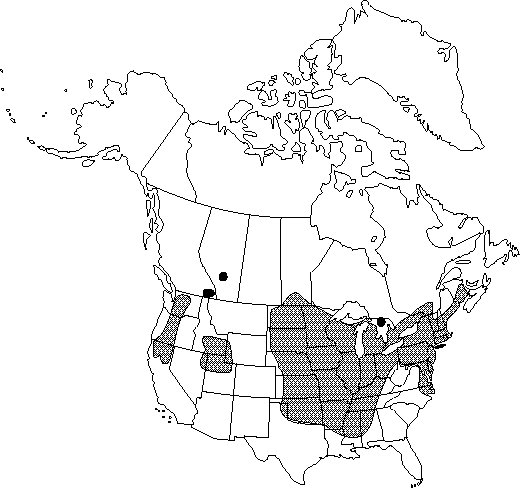Difference between revisions of "Ranunculus flabellaris"
Amer. Monthly Mag. & Crit. Rev. 2: 344. 1818.
FNA>Volume Importer |
FNA>Volume Importer |
||
| Line 17: | Line 17: | ||
|basionyms= | |basionyms= | ||
|synonyms={{Treatment/ID/Synonym | |synonyms={{Treatment/ID/Synonym | ||
| − | |name= | + | |name=Ranunculus delphinifolius |
|authority=Torrey | |authority=Torrey | ||
}} | }} | ||
| Line 34: | Line 34: | ||
|elevation=0-1500 m | |elevation=0-1500 m | ||
|distribution=Alta.;B.C.;Man.;N.B.;Ont.;Que.;Ala.;Ark.;Calif.;Conn.;Del.;Idaho;Ill.;Ind.;Iowa;Kans.;Ky.;La.;Maine;Md.;Mass.;Mich.;Minn.;Miss.;Mo.;Nebr.;Nev.;N.H.;N.J.;N.Y.;N.C.;N.Dak.;Ohio;Okla.;Oreg.;Pa.;R.I.;S.Dak.;Tenn.;Tex.;Utah;Vt.;Va.;Wash.;Wis.;Wyo. | |distribution=Alta.;B.C.;Man.;N.B.;Ont.;Que.;Ala.;Ark.;Calif.;Conn.;Del.;Idaho;Ill.;Ind.;Iowa;Kans.;Ky.;La.;Maine;Md.;Mass.;Mich.;Minn.;Miss.;Mo.;Nebr.;Nev.;N.H.;N.J.;N.Y.;N.C.;N.Dak.;Ohio;Okla.;Oreg.;Pa.;R.I.;S.Dak.;Tenn.;Tex.;Utah;Vt.;Va.;Wash.;Wis.;Wyo. | ||
| − | |discussion=<p>The Fox tribes used Ranunculus flabellaris as a cold remedy and a respiratory aid (D. E. Moerman 1986).</p> | + | |discussion=<p>The Fox tribes used <i>Ranunculus flabellaris</i> as a cold remedy and a respiratory aid (D. E. Moerman 1986).</p> |
|tables= | |tables= | ||
|references= | |references= | ||
| Line 47: | Line 47: | ||
|rank=species | |rank=species | ||
|parent rank=section | |parent rank=section | ||
| − | |synonyms= | + | |synonyms=Ranunculus delphinifolius |
|basionyms= | |basionyms= | ||
|family=Ranunculaceae | |family=Ranunculaceae | ||
| Line 58: | Line 58: | ||
|publication year=1818 | |publication year=1818 | ||
|special status=Endemic;Weedy | |special status=Endemic;Weedy | ||
| − | |source xml=https://jpend@bitbucket.org/aafc-mbb/fna-data-curation.git/src/ | + | |source xml=https://jpend@bitbucket.org/aafc-mbb/fna-data-curation.git/src/8f726806613d60c220dc4493de13607dd3150896/coarse_grained_fna_xml/V3/V3_1051.xml |
|genus=Ranunculus | |genus=Ranunculus | ||
|subgenus=Ranunculus subg. Ranunculus | |subgenus=Ranunculus subg. Ranunculus | ||
Revision as of 17:13, 18 September 2019
Stems floating or prostrate, glabrous, rooting at proximal nodes. Leaves: basal leaves seldom present, cauline leaf blades semicircular to reniform, 1-6×-lobed, parted, or dissected 1.2-7.3 × 1.9-10.8 cm, base truncate or cordate, segment margins entire or crenate, apex rounded to filiform. Flowers: receptacle sparsely hispid; sepals 5, spreading or weakly reflexed, 5-7 × 3-6 mm, glabrous; petals 5-6(-14), 7-12 × 5-9 mm; nectary scale variable, crescent-shaped, funnel-shaped, or flaplike; style 0.8-1.2 mm. Heads of achenes ovoid, 8-10 × 7-8 mm; achenes 1.8-2.2 × 1.6-2.2 mm, glabrous; beak lanceolate, straight, 1-1.8 mm. 2n = 32.
Phenology: Flowering late spring–summer (May–Aug).
Habitat: Shallow water or drying mud
Elevation: 0-1500 m
Distribution

Alta., B.C., Man., N.B., Ont., Que., Ala., Ark., Calif., Conn., Del., Idaho, Ill., Ind., Iowa, Kans., Ky., La., Maine, Md., Mass., Mich., Minn., Miss., Mo., Nebr., Nev., N.H., N.J., N.Y., N.C., N.Dak., Ohio, Okla., Oreg., Pa., R.I., S.Dak., Tenn., Tex., Utah, Vt., Va., Wash., Wis., Wyo.
Discussion
The Fox tribes used Ranunculus flabellaris as a cold remedy and a respiratory aid (D. E. Moerman 1986).
Selected References
None.